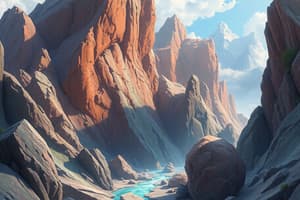Podcast
Questions and Answers
What is the process that causes the layers of sand and mud at the bottom of lakes and oceans to turn into sedimentary rocks?
What is the process that causes the layers of sand and mud at the bottom of lakes and oceans to turn into sedimentary rocks?
- Erosion
- Heat
- Pressure (correct)
- Deposition
What does the relative age of rocks explain?
What does the relative age of rocks explain?
- The location of rocks
- The order of rock layers (correct)
- The exact age of rocks
- The composition of rocks
What forms when ancient living things die and become preserved in rocks?
What forms when ancient living things die and become preserved in rocks?
- Minerals
- Metamorphic rocks
- Fossils (correct)
- Sedimentary rocks
What can rocks provide clues about?
What can rocks provide clues about?
What indicates the order in which rock layers were formed?
What indicates the order in which rock layers were formed?
What is the process by which fossils are formed in stone?
What is the process by which fossils are formed in stone?
What can be inferred from the types of fossils found in a particular area?
What can be inferred from the types of fossils found in a particular area?
What can cause rock layers to change their original order?
What can cause rock layers to change their original order?
What can scientists use to determine the age of rocks?
What can scientists use to determine the age of rocks?
What can be learned from the Petrified Forest?
What can be learned from the Petrified Forest?
Flashcards are hidden until you start studying
Study Notes
Formation of Sedimentary Rocks
- Sedimentary rocks form in layers over millions of years, similar to the pages of a book.
- Each layer is formed through the compression of sand and mud at the bottom of lakes and oceans.
- The pressure from the weight of the layers causes the sand and mud to turn into sedimentary rocks.
Characteristics of Sedimentary Rocks
- Sedimentary rocks display distinct layers or stripes, which may be different colors.
- Newer layers are found at the top of the sequence, while the oldest layers are at the bottom.
- Scientists can determine the relative age of rocks by examining their position in the sequence.
Fossils in Sedimentary Rocks
- Fossils are formed when ancient living organisms die and become preserved in sedimentary rocks.
- Fossils provide clues about the age of the rocks in which they are found.
- The presence and location of certain fossil types indicate the order in which rock layers were formed.
- Fossils in the bottom layers are very different from organisms alive today, and become more familiar as you move up to younger rock layers.
Environmental Clues from Fossils
- Fossils can reveal information about the environment in the past, such as the type of environment, food sources, and more.
- Fossils found in a particular area can indicate what the environment was like in the past, such as whether it was a desert or ocean.
Forces and Change
- Earthquakes and tectonic plate movement can cause rock layers to change, disturbing their original order.
- Pressure and temperature can cause rock layers to bend or fold over.
- Scientists can determine the original order of the layers by comparing disturbed rock layers with undisturbed layers.
Studying That Suits You
Use AI to generate personalized quizzes and flashcards to suit your learning preferences.





